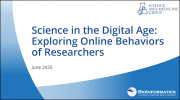
|
시장보고서
상품코드
1759017
디지털 시대의 과학 : 연구자의 온라인 행동 조사Science in the Digital Age: Exploring Online Behaviors of Researchers |
||||||
"디지털 시대의 과학 : 연구자의 온라인 행동 조사'는 BioInformatics의 새로운 보고서로, 양적 및 질적 방법을 사용하여 과학자들이 자연스럽게 온라인에 끌리는 곳을 조사하는 새로운 보고서로, 545명 이상의 과학 연구자들을 대상으로 조사한 이 보고서는 그들의 개인적 및 업무적 온라인 습관에 대해 설명합니다. 온라인 습관. 어떤 웹사이트, 소셜미디어 플랫폼, 인플루언서가 연구자들 사이에서 인기가 있는지, 그리고 과학자들이 이러한 리소스에 대해 얼마나 신뢰하는지를 알 수 있습니다. 이 보고서는 채널 전략과 메시지 전략에 도움이 되는 데이터에 기반한 인사이트를 제공합니다.
이 최신 보고서에서는 연구자들의 현재 온라인 습관을 개괄하고 다음과 같은 목적에 초점을 맞추고 있습니다.
- 과학자들이 자연스럽게 온라인을 이용하는 장소를 조사하고, 업무/경력 관련 주제와 개인적 용도로 온라인을 얼마나 자주 이용하는지 파악합니다.
- 과학자들은 어떤 온라인 뉴스레터를 구독하고 있는가? 과학자들은 어떤 다른 온라인 미디어(비과학 관련 채널 포함)를 소비하고 있는가?
- 과학자들은 어떤 방식으로 온라인을 이용하는가? 과학자들이 특정 과학 소셜미디어나 커리어 관련 사이트에 접속하는 목적은 무엇인가?
- 사람들은 어떤 과학 관련 포럼에 접속하는가? 이 포럼들을 어떻게 알게 되었는가?
- 온라인에서 어떤 주제(과학 및 비과학 관련)에 대해 조사하는가? 그들은 어디에서 그 정보를 찾는 것을 신뢰하는가?
- 과학자들이 팔로우하는 온라인 상의 주요인플루언서가 누구인지, 어떤 채널을 통해 그 미디어를 소비하는지 알아봅니다. 그리고 어떻게 그 인플루언서들을 알게된 것일까?
BioInformatics는 이 목적을 달성하기 위해 온라인 정량적 설문조사와 그에 수반되는 정성적 인터뷰를 실시했습니다.
이 보고서의 기반이된 설문조사는 총 545명의 응답자와 시장 조사에 참여의지가 높은 과학자 커뮤니티의 일원인 과학자문위원회(SAB) 회원 7명을 대상으로 1:1 인터뷰를 통해 이루어졌습니다.
목차
제1장 연구 개요
제2장 개요
제3장 인구통계
제4장 온라인 리소스의 전체적인 이용
제5장 소셜미디어 이용
제6장 사상적 리더 또는 인플루언서
제7장 과학 관련 웹사이트
제8장 온라인 이벤트
제9장 과학 뉴스 미디어 또는 블로그
제10장 검색 엔진 사용
제11장 조사 방법
제12장 조사회사 소개
제13장 부록
KSA 25.07.08"Science in the Digital Age: Exploring Online Behaviors of Researchers" is a new report from BioInformatics that investigates where scientists are naturally gravitating online using both quantitative and qualitative methods. Surveying over 545 science researchers, this report describes their personal and professional online habits. You'll discover which websites, social media platforms, and influencers are popular among researchers and the level of trust scientists have in these resources. This report offers data-backed insights to inform channel and messaging strategies.
This NEW report outlines current online habits of researchers and will focus on the following objectives:
- Investigate where scientists are naturally gravitating online and understand how often they go online for both job/career-related topics and personal use.
- What online newsletters do scientists subscribe to? What other online media (including non-science related channels) do they consume?
- How are scientists deciding where to go online? What are the purposes behind scientists accessing specific scientific social media or career-based sites?
- Which science related forums are people accessing? How did they learn about these?
- What topics are they investigating online (science and non-science related)? Where would they trust finding this information?
- Investigate who key online influencers are that scientists follow and through what channels to they consume that media. Understand how did they hear about those influencers in the first place?
BioInformatics designed an online quantitative survey with accompanying qualitative interviews to address the objectives.
The survey this report was based on was fielded to n=545 respondents and n=7 one-on-one interviews, members of the Science Advisory Board (SAB) - a segment of the scientific community with a demonstrated willingness to participate in market research activities.


















